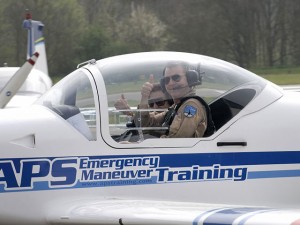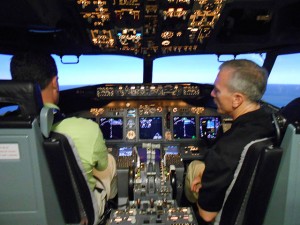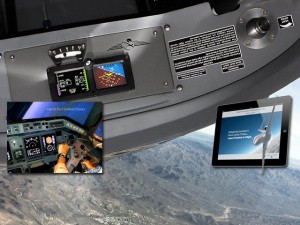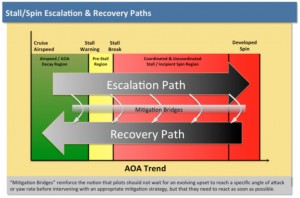Executive Summary
The importance of practicing upset recovery in developing the skills to prevent airplane upsets before they occur is generally under appreciated.
In an unexpected airplane upset event, interrelated factors in aircraft handling, inability to comprehend unfamiliar stimuli, and the psychological stressors of surprise, startle, and fear can combine to create compound threats. In a similar fashion, the integration of various elements of Upset Prevention and Recovery Training (UPRT) can reinforce each other in a manner that amplifies individual learning outcomes and supports overall comprehension and retention.
 The following high-level topics are addressed in greater detail within the document.
The following high-level topics are addressed in greater detail within the document.
Multiple Benefits of Upset Recovery
- There is a quantifiable benefit from training to recover from airplane upsets beyond developing recovery skills. Increasing awareness, which assists in prevention through recognition and avoidance of escalating upset conditions, is a byproduct of recovery.
How Recovery Enhances Prevention
- The performance enhancement from training in upset recovery comes not only from knowing what to do, but being able to process that information in an upset because of the overall familiarity with the situation gained through the upset training process.
Upset Recovery Skills are Unique
- There are many examples to illustrate this critical situation: the way that we would utilize controls in normal flight could be inappropriate in an upset event. In these cases, training in prevention alone will not provide the necessary practice of counter-intuitive skills required to develop the ability to rapidly apply correct inputs in the time available.
Training Platforms
- Both airplanes and Flight Simulation Training Devices (FSTDs) can be used for practical skill development in UPRT. Each has unique strengths and limitations.
- In order to provide essential training with the appropriate margin of safety, airplanes certified in the acrobatic category must be used.
- Proper UPRT instruction in flight simulators must stay within the valid training envelope, and should be delivered by qualified instructors who have been provided with aircraft training which illustrates simulation’s limitations.
Integration of Key Factors
- Integrated delivery of UPRT elements provides synergistic benefits in comprehension, effectiveness, and retention.
Written By Randall Brooks and Paul ‘BJ’ Ransbury
Introduction
There is an increasing awareness across the aviation community that the threat of Loss of Control In-flight (LOC-I) must be addressed. Across the spectrum of aviation, from personal flying, to flight instruction, business and corporate aviation, and in airline operations, LOC-I causes a greater number of deaths in aviation than any other causal factor. While this collective awareness is relatively new and growing, and a full level of understanding and appreciation of the problem is still building amongst the overall pilot population, the appropriate response is currently in debate.
While Aviation Performance Solutions (APS) does not hold greater knowledge or wisdom than others, we do possess insights gained from the training of more pilots in the techniques of defeating LOC-I than any other current civilian training provider. It is from that perspective that these thoughts are presented.
An unexpected airplane upset combines elements of disorientation, the psychological challenges of startle and surprise, and skills unique to the upset environment. These elements interact to create an often insurmountable challenge that has defied effective recovery for too many pilots.
This integrated set of challenges can only be overcome by training that combines all of the aspects that are tested by an upset event. By systematically integrating the necessary academic, psychological, and manual handling aptitudes, we can defeat the threat of LOC-I through robust and comprehensive UPRT.
 The Status Quo
The Status Quo
One of the reasons that aviation has reached the pinnacle of transportation safety is the fact that it is a conservative enterprise. By building steadily upon the knowledge of what works best, we have created the safest form of transportation that the world has known. This fundamental Safety Management System (SMS) approach began long before the formal principles of today’s SMS were ever identified. There is an inherent desire in aviation to go forward as we have in the past, improving safety steadily in what we do.
While this has led to great success in most areas of flying and has allowed one threat after another to fade to the background, this approach has not worked for LOC-I. For multiple decades the LOC-I accident rate has remained high, and the fact that it has remained constant is disturbing. History shows that with respect to LOC-I, conventional measures will not succeed. Yet as we leave the beaten path of what is familiar, we must be twice as prudent in our actions, for we may fail in two ways: 1) by not being bold enough to think of new options that can break the pattern of LOC-I accidents, or 2) by promoting changes which do not adequately consider unintended results of our efforts.
One thing is guaranteed: doing what we are currently doing will give us the same results we’ve been getting. In order to reduce the LOC-I accident rate, something must change. The impediments to this change fall into two main camps.
The first obstacle is expense. Upgrading simulators, using more capable aircraft, and standardizing instructors all represent major investments.
The second issue is conceptual. We must allow ourselves to be open to new possibilities. Not just the positive possibilities regarding the development of new skills in pilots, but also the negative possibilities regarding potential outcomes from utilizing aircraft in training in roles that could minimize margins of safety. We must realistically envision the potential outcomes of such training.
We must realize that when we delve into the evolving arena of UPRT, some counter-intuitive relationships exist. Indeed, the accident rate would not be what it is if aircraft and pilot behavior were the same beyond the upset threshold that they are before that boundary is passed. Non-linear relationships exist in both the escalating demands on the pilot in an upset, as well as in the augmenting benefits of training. We must understand that there are synergies in both the hazards confronting pilots in an upset as well as in how comprehensive and integrated training can provide appropriate strategies as a response.
Preventing an aircraft upset in the first place must always be our primary goal; history clearly shows us this is not always possible. Let’s look at the best way to establish the skills necessary for upset prevention, and how training in recovery enhances those skills.
The Multiple Benefits of Training in Upset Recovery
It is obvious that training for recovery from upsets provides pilots with knowledge and skills that are beneficial in the unfortunate event that a point is reached where recovery is called for. This immediate and simple relationship obscures the more important benefit that comes from training in upset recovery.
Pilots who have no experience with the region of the flight envelope that exists beyond where we normally operate cannot fully comprehend the threat that waits for them in regions they have not visited. Regardless of pilot experience, the type of aircraft, the weather or time of day, one factor in an upset will be the same for every pilot who has not passed the thresholds that define the boundaries of an unanticipated airplane upset. It will be an unknown.
Some will underestimate that unknown. They will trust that the skills and competence that they possess in the normal envelope will be enough, and that the instincts and skills they have developed will see them through. Others may view what lies beyond the limits of their experience with anxiety that does not improve performance, but overwhelms it when it is needed most.
It is difficult to imagine the unknown, and it is even more difficult to prevent what we can’t imagine. Those who have not experienced the development of an upset in training are less likely to anticipate the approach of an event they have never seen. Therein lies the most overlooked benefit of upset recovery training: prevention.
The dramatic improvement in awareness that is developed from seeing the progression of a variety of developing upsets in training teaches us not only how to recover, but how to detect an escalating upset in the first place. It is difficult to convey the degree of startle and surprise a pilot experiences when an airplane behaves in a way they have never seen or thought possible. With the understanding gained through the repeated practice of recovery, a mental model is developed which—if introduced correctly—will represent the characteristics and behavior of a broad range of fixed wing aircraft.
By seeing the repeated escalation of events which culminate in an upset, a pilot learns the infinite mitigating pathways or “off ramps” that allow recovery at progressive stages of an upsets progression. This allows for the interruption of a developing undesired aircraft state before an upset occurs, which constitutes prevention. The practice of upset recovery is simply the most practical and effective method to develop the skills of upset prevention. Combined with the redundant safety net of recovery skills, this overall approach represents the best comprehensive solution to mitigating LOC-I.
How Recovery Training Significantly Enhances Prevention
Pilots generally think of the ability to recover from upsets in terms of manual handling skills. What is critical to understand is the pilot’s ability to perform correctly in the face of an upset event is based not only on the knowing what to do and how to apply those stick-and-rudder skills, but also having the cognitive capacity to execute those functions. This necessary mental discipline in the face of an upset is under-appreciated and can only be developed through practice in the actual upset environment.
A pilot’s ability to operate effectively in the presence of a time-critical, life-threatening upset event depends just as much on the ability to contain and manage the surprise and startle as it does on knowing what to do. For the pilot who is not exposed through training to the sensory overload and dynamic aircraft behavior that can occur in an upset event, it can often be incapacitating. The combined effect of attitudes that have not been experienced, unfamiliar g-loads, aural and visual warnings and other stimuli can overtax a pilot’s ability to mentally process all that is occurring, in a worst case causing “cognitive lock” resulting in the inability to react or reacting improperly. This “system overload” can materialize even if a pilot completely understands the theoretical basis for what is happening. Academic information can become inaccessible in the presence of such a confusing and threatening situation.
The definition of an airplane upset describes not only attitudinal disturbances, but also inappropriate speeds for the phase of flight. These airspeed deviations can result in increased angles of attack, stalls, and the onset of spins. Again, recovery from a stall or spin has as much to do with the ability to function in a reliable manner mentally as it does with knowing how to manipulate the controls. Both capabilities are necessary for a safe and effective recovery, and both are enhanced through training in upset recovery.
Knowing how the story unfolds, having seen the escalation of angle of attack and what results beyond critical angle of attack from watching such situations develop during training, gives the pilot experienced in UPRT a greatly enhanced capability to intervene. The awareness of what can result helps the trained pilot correctly anticipate trends that could result in an upset and take corrective steps at an earlier stage.
To understand how the mental and physical disorientation of an untrained pilot can result in catastrophic impairment, we must appreciate the criticality of the time available. NASA and Boeing studies have shown that there may be as little as 6-10 seconds between reaching the threshold of an upset to the point where a safe recovery is no longer possible[1]. Thus, even a small delay in a pilot’s response can have disastrous results.
The performance enhancement from training in upset recovery comes not only from the knowing what to do, but being able to process that information in an upset because of the overall familiarity gained through the upset training process.
Different Aircraft States Require Different Skills
As important as it is to keep from being overcome by the mental and psychological aspects of an upset event, having the capacity to apply the correct control inputs is equally crucial. There is a common belief that the skills learned and used in everyday flight in normal circumstances will be all that are required in an airplane upset. Unfortunately, there are many examples where the way that we would utilize controls in normal flight would be inappropriate in an upset event.
In these cases, training in prevention alone will not provide the necessary practice of counter-intuitive skills required to develop the ability to rapidly apply correct inputs in the time available. You have to reach the recovery stage to practice their implementation. Let’s consider a few examples.
For the pilot who has trained exclusively in the normal operating regime, there is a consistent response to back pressure on the flight controls. Pulling back brings the nose up, gains altitude, and slows the airplane if power is not adjusted. For a level turn the back pressure required to maintain level flight increases as the bank angle gets steeper. The problems begin at what is called the critical bank angle, which is the bank angle which will result in the maximum rated G-limit, or limit load for the aircraft. For a transport category aircraft the standard limit load of 2.5 G will be reached at 66o of bank. Beyond this bank angle the airplane will either be overloaded if back pressure increases, or it will begin to lose altitude despite the back pressure on the controls. Beyond the critical bank angle, the rules change. For someone who has not been beyond this bank angle before, running into this new set of rules during an upset can begin the process of control loss. Unfortunately, the situation gets worse.
Beyond 90o of bank, back pressure brings the nose down, and speed increases as altitude is rapidly lost. The pilot untrained in upset recovery experiences a psychophysiological spike due to bewilderment, and rapidly loses confidence and situational awareness. The untrained pilot generally has no ability to analyze a situation that has never been seen, which is followed quickly by incapacitating fear. Now—amidst this mayhem—tried and true control inputs have a different result in this attitude. As we have addressed earlier regarding cognitive skills, knowing why this is happening may not be enough the first time these differences are experienced. It is unlikely that the necessary counter-intuitive control inputs will be determined quickly, or at all.
There are other examples of specialized skills required in the context of an upset recovery. There is no problem with simultaneous rolling and pulling control inputs in the normal envelope, but in recovery situations at elevated G loadings the asymmetrical wing loadings can reduce the structural margin of safety to the point where a failure could occur. Elevated G levels are not normally thought of as being conservative, but in certain dive recoveries increasing the G level to the limit load is less risky than allowing an airplane to exceed its maximum operating velocity (VMO). These are a few examples where operations in the normal envelope will not adequately prepare pilots or provide the skills required outside of the normal operating envelope.
In upset situations, energy can be traded at a rate that pilots will be unfamiliar with if they have not experienced it before. Severe nose high or nose low conditions will result in decelerations and accelerations respectively that will create speed divergence at a rate beyond what untrained pilots are accustomed too. This extreme energy divergence will be inadequately compensated by a pilot unfamiliar with such rates of change, which can result in either low speed (stall) or high speed (structural) exceedances.
A point to consider about recoveries from upsets is that they will always be unplanned. If an airplane deviation is detected as it is developing, it will always be countered. As the Airplane Upset Recovery Training Aid[2] puts it: “It should be emphasized that recovery to a stabilized flight path should be initiated as soon as a developing upset condition is recognized.” Obviously, the unplanned nature of upset events dramatically heightens the presence of surprise and startle and the cognitive impact these psychological factors can have.
While all of these situations pose a threat to the untrained pilot, the even greater problem is that these issues and considerations, which do not even exist in the region of normal flight operations, are additive. The compounding nature of a situation requiring upset-specific skills combined with the psychological and mental impact that can impede cognition and reliable performance begins to explain why LOC-I is the leading cause of fatalities in aviation.
 Appropriate Use of Training Platforms
Appropriate Use of Training Platforms
It is through the practice of upset recovery in flight where theory truly becomes reality; where pilot stress levels can be manipulated to levels comparable to those of real-life upsets, but in a controlled learning environment where techniques can be perfected and the bonds to mental models for recovery become permanently ingrained. It is through on-airplane practice of upset recovery where pilots gain necessary confidence in the training methodology and where insight into mitigating pathways of recovery is fostered.
Comprehensive upset recovery necessarily includes, among other things, intentional training operations near and above critical angle of attack (AOA) and to extreme bank angles not encountered during routine flight. UPRT must involve hands-on experience beyond 45⁰ of bank, and more importantly, to 180⁰ of bank. UPRT must also involve hands-on experience at high AOA, including full aerodynamic stalls with sideslip present which clearly demonstrates the effects of the presence of yaw on stall behavior. A pilot who has never seen an extreme bank angle approaching inverted, or seen an aircraft begin to enter a spin often doesn’t even recognize what it is occurring, let alone what control inputs are required to prevent it.
During licensing training, on-airplane UPRT must make use of aircraft approved for intentional spins which are capable of operation in the acrobatic category. Upset training will not be complete unless and until the pilot can experience training in an airplane certified in the acrobatic category. Training in the acrobatic category offers the widest range of possible maneuvers, the greatest aerodynamic and structural margins of safety. Regardless of the airplane being used, the safe and legal delivery of UPRT requires due consideration of the training airplane’s approved operating limitations, design limits, and available margins of safety.
 While the use of Flight Simulation Training Devices (FSTDs) in delivering UPRT can never create the mental and psychological impact encountered to the same degree which is encountered in actual flight, they can be useful tools for learning correct upset recovery methodology if used within their valid training envelope. The valid training envelope encompasses the range of the simulator data package where information was gathered in flight test or validated by a pilot with relevant experience in that aircraft type in the pertinent region of the maneuvering envelope. Practice and the development of technique in un-confirmed regions of the flight envelope could elicit inaccurate or false response from the device leading to negative training.
While the use of Flight Simulation Training Devices (FSTDs) in delivering UPRT can never create the mental and psychological impact encountered to the same degree which is encountered in actual flight, they can be useful tools for learning correct upset recovery methodology if used within their valid training envelope. The valid training envelope encompasses the range of the simulator data package where information was gathered in flight test or validated by a pilot with relevant experience in that aircraft type in the pertinent region of the maneuvering envelope. Practice and the development of technique in un-confirmed regions of the flight envelope could elicit inaccurate or false response from the device leading to negative training.
The key in the use of FSTDs in the delivery of UPRT is that the instructor must be specifically qualified in the delivery of UPRT, and familiar with the limitations of the simulator. The best way for a simulator UPRT instructor to appreciate the missing elements of G awareness, motion cueing, aerodynamic fidelity, and reduced psychological impact in the simulator environment is through the experience of UPRT in an aircraft. This first-hand experience can be translated into a more accurate appreciation for the limitations of the simulator in the delivery of UPRT that helps to avoid use of the device in a manner leading to negative training.
 Integration of Key Factors: The Sum Equals More Than the Parts
Integration of Key Factors: The Sum Equals More Than the Parts
We have discussed the fact that an important role of training in recovery is to enhance awareness which can aid prevention. Through training in recovery, pilots develop mental models that illustrate how upsets occur. This fosters the ability to recognize and avoid patterns that lead to upsets and prevent them before they can occur.
We have seen that there are several areas of aircraft handling, energy management, and maneuvering techniques that cannot be experienced in normal flight and will remain mysteries to pilots who have not been trained in how to escape the specific challenges presented by an airplane upset. We have touched upon the mental and psychological obstacles formed by previously unseen or experienced attitudes and stimuli. We have even covered the compounding nature of these different phenomena into an incapacitating tangle of unfamiliar problems, which cannot be solved by otherwise skilled pilots in the time that is available.
Despite these multiple, intertwined challenges that can confront a pilot in an unexpected upset event, there is good news in the delivery of UPRT. The same compounding effect of various aerodynamic, physical, mental, and psychological factors that interrelate to conspire against pilots in an upset can be defeated by the same interrelationship of factors in training.
 There is an intangible multiplier in UPRT. When proper aerodynamic instruction precedes a flight or simulator session, then important principles are understood and brought to life in practical demonstrations. When a well-trained and standardized instructor delivers training in the aircraft in a patient but thorough and understanding manner, anxiety that can block the consolidation of information goes away. When lessons are structured in a way that builds skill and comprehension in a step-by-step manner, each step leads to the next in a way that makes important lessons seem obvious. In allowing the student the time required to practice with enough repetition to incorporate the proficiency that is required, essential skills are developed and become automatic.
There is an intangible multiplier in UPRT. When proper aerodynamic instruction precedes a flight or simulator session, then important principles are understood and brought to life in practical demonstrations. When a well-trained and standardized instructor delivers training in the aircraft in a patient but thorough and understanding manner, anxiety that can block the consolidation of information goes away. When lessons are structured in a way that builds skill and comprehension in a step-by-step manner, each step leads to the next in a way that makes important lessons seem obvious. In allowing the student the time required to practice with enough repetition to incorporate the proficiency that is required, essential skills are developed and become automatic.
Once a pilot sees the result of this comprehensive approach they develop confidence, warranted by their own actions in demonstrated recovery. The benefit that comes from the belief that they are able to safely and effectively handle an unexpected upset is essential to the ability to react reliably and consistently despite the shock encountered in an unexpected upset.
Just as the threat is complicated by the manner in which various upset factors conspire against the untrained pilot, integrating various elements of UPRT has a synergistic result which has a multiplying effect beyond each individual element taken separately. The end result of this training is a highly aware, self-assured, pilot who carries the confidence earned through demonstrated proficiency.
As significant as these benefits already identified are, there are two additional benefits that result from UPRT.
- First, the same awareness developed in a pilot who receives comprehensive UPRT is not only applicable to themselves. As a Pilot Monitoring, the enhanced awareness brought forth through UPRT can be applied to the monitoring skills they employ when observing others. The same pattern development and escalating trends that will have been honed in the development of recovery skills can be brought to bear in recognizing and avoiding developing undesired aircraft states when others are flying.
- Secondly, the manual handling skills brought forth in the necessary practice of recovery are useful and relevant in normal flight operations. The first step in recovery is almost always to reduce the level of automation until the recovery is complete. Whether it is in the smooth and gentle management of G, an increased appreciation for the trade-off between airspeed and altitude, or just greater confidence in flying without automation, the contribution to manual handling skills from UPRT is beneficial to safety and gratifying to pilots.
The basis of our problem with LOC-I primarily stems from missing elements of pilot training specific to upset conditions. These omissions can be incorporated into UPRT as has been outlined here. The reason that certain elements of training which would aid upset prevention and recovery are absent from civil flight training requirements is based on four assumptions that are generally made regarding existing flight training. These assumptions are entirely valid in the normal flight envelope. Unfortunately, these assumptions are often misapplied in the realm of airplane upsets, where their validity breaks down.
- The first assumption is that the airplane is going to stay in the normal operating envelope for which it is designed. If we assume this to be true then there is really no point in training pilots for flight outside of the normal envelope. History has proven that despite our best efforts at prevention, aircraft do occasionally stray from their normal operating limits. We have covered how the untrained pilot is inadequately prepared to deal with such situations – which were assumed not to occur.
- The second assumption is that all of the skills that pilots acquire during existing licensing training contain the skills they will need to effectively deal with an upset event. We have identified an incomplete list of aerodynamic, physical, flight, control, and energy management factors which are different in upset conditions, are counter-intuitive, and are additive in the complexity that they can pose.
- The next assumption is that the pilot will be able to make sense out of all of the sensory inputs that they encounter during an upset event and will be able to clearly assimilate all of this information – much of which they will never have seen before in their life – to accurately assess not only what is wrong with their aircraft state, but precisely what to do about it.
- Last we assume that in spite of the assumptions that a) their airplane would never leave its normal envelope, b) that they didn’t need any additional training for upsets, and c) that they would fully comprehend what was happening to them in an upset despite never having seen it before, pilots will react in a reliable and predictable manner. That is, we assume that in an unexpected airplane upset event pilots will do just what we would expect them to do, and execute it dependably.
In order to test the theories put forth above a study was conducted to evaluate how these assumptions held up in the real world[3]. Twenty worldwide airline LOC-I accidents were evaluated covering a ten-year period. Sixteen of the accidents yielded usable data. Did the airplanes stay in the normal envelope? Not in most cases (62.5% of the instances were out of the normal envelope). Did pilots have the skills required from existing training? Not the majority of the time (68.8% of the situations called for skills not required by current practical test standards). Did they understand what was happening to them given the information that they had? Usually not (68.8% were not fully aware of the situation).
The most revealing finding was with regard to the assumption that when confronted with an upset event, pilots would react in a reliable and predictable manner. In all sixteen accidents that had data that could be evaluated, the pilots did not do what their training would have instructed them to do. They did not perform in a manner that was consistent with how they would have been trained to react in those situations. If 100% of the pilots involved in the fatal accidents evaluated in the study did not do what they were trained to do, it suggests that there may be a systemic problem with our training. We believe that this is due to gaps in training that do not adequately prepare pilots for upset events, and that comprehensive UPRT is the best way to mitigate this threat.
 Conclusion
Conclusion
The following points represent the essential messages presented. Better understanding of the non-intuitive nature of certain aspects of UPRT will help to achieve industry consensus which can help drive a collective response to reducing the LOC-I accident rate.
Recovery Skills are Different
- There are many examples where the way that we would utilize controls in normal flight would be inappropriate in an upset event.
Psychopysiological Factors Compound in a Unique Way
- The interrelated mental, psychological, physical, and technical handling challenges confronted in an upset event weave together to create a considerable challenge for an untrained pilot.
Redundancy
- The combination of well-developed skills in upset prevention along with the redundant safety net of upset recovery skills represents the most comprehensive solution to mitigating the LOC-I threat.
Recovery Enhances Prevention
- The development of mental modeling and pattern recognition derived through the practice of upset recovery is the most practical and effective method to develop the skills necessary for upset prevention.
[1] Wilborn, J.E. and Foster, J.V., “Defining Commercial Transport Loss-of-Control: A Quantitative Approach”, p. 9, American Institute of Aeronautics and Astronautics Atmospheric Flight Mechanics Conference and Exhibit, Providence, Rhode Island, 2004.
[2] Airplane Upset Recovery Training Aid, http://www.faa.gov/other_visit/aviation_industry/airline_operators/training/media/AP_ UpsetRecovery_Book.pdf.
[3] Brooks, R.L and Ransbury, P., “Unexpected Pilot Performance Contributing to Loss of Control in Flight (LOC-I)”, American Institute of Aeronautics and Astronautics Modeling and Simulation Technologies Conference, Minneapolis, MN, 2012.
* * *
About the Authors
Randy Brooks is a Master Instructor, member of the Society of Aviation and Flight Educators (SAFE), UPRT instructor, and VP of Training with a background in many facets of business aviation. His airshow acrobatic experience includes formation team demonstrations, jet aircraft, and sailplanes. He has delivered more than 3000 hours of flight instruction and is President of UPRTA.
Paul ‘BJ’ Ransbury is the President of Aviation Performance Solutions, a multi-national flight school that trains more than 1000 professional jet pilots annually in integrated UPRT. He is a four-time Master Instructor, SAFE member, former airline pilot, military fighter pilot and fighter weapons instructor course graduate with more than 4500 hours of flight instruction in piston and jet aeroplanes.





Comments: